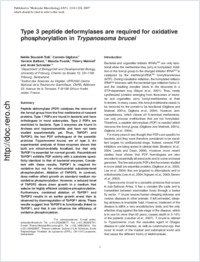Type 3 peptide deformylases are required for oxidative phosphorylation in Trypanosoma brucei
- Bouzaidi-Tiali, Nabile Department of Biology/Cell and Developmental Biology, University of Fribourg, Switzerland
- Giglione, Carmela Institut des Sciences du Végétal, Centre National de la Recherche Scientifique, Gif-sur-Yvette, France.
- Bulliard, Yannick Department of Biology/Cell and Developmental Biology, University of Fribourg, Switzerland - School of Life Sciences, Ecole Polytechnique Fédérale de Lausanne, Switzerland
- Pusnik, Mascha Department of Biology/Cell and Developmental Biology, University of Fribourg, Switzerland
- Meinnel, Thierry Institut des Sciences du Végétal, Centre National de la Recherche Scientifique, Gif-sur-Yvette, France.
- Schneider, André Department of Biology/Cell and Developmental Biology, University of Fribourg, Switzerland
-
14.08.2007
Published in:
- Molecular Microbiology. - 2007, vol. 65, no. 5, p. 1218-1228
English
Peptide deformylase (PDF) catalyses the removal of the formyl group from the first methionine of nascent proteins. Type 1 PDFs are found in bacteria and have orthologues in most eukaryotes. Type 2 PDFs are restricted to bacteria. Type 3 enzymes are found in Archaea and trypanosomatids and have not been studied experimentally yet. Thus, TbPDF1 and TbPDF2, the two PDF orthologues of the parasitic protozoa Trypanosoma brucei, are of type 3. An experimental analysis of these enzymes shows that both are mitochondrially localized, but that only TbPDF1 is essential for normal growth. Recombinant TbPDF1 exhibits PDF activity with a substrate specificity identical to that of bacterial enzymes. Consistent with these results, TbPDF1 is required for oxidative but not for mitochondrial substrate-level phosphorylation. Ablation of TbPDF2, in contrast, does neither affect growth on standard medium nor oxidative phosphorylation. However, a reduced level of TbPDF2 slows down growth in a medium that selects for highly efficient oxidative phosphorylation. Furthermore, combined ablation of TbPDF1 and TbPDF2 results in an earlier growth arrest than is observed by downregulation of TbPDF1 alone. These results suggest that TbPDF2 is functionally linked to TbPDF1, and that it can influence the efficiency of oxidative phosphorylation.
- Faculty
- Faculté des sciences et de médecine
- Department
- Département de Biologie
- Language
-
- English
- Classification
- Biological sciences
- License
- License undefined
- Identifiers
-
- RERO DOC 8388
- DOI 10.1111/j.1365-2958.2007.05867.x
- Persistent URL
- https://folia.unifr.ch/unifr/documents/300405
Statistics
Document views: 92
File downloads:
- schneider_tpr.pdf: 104
